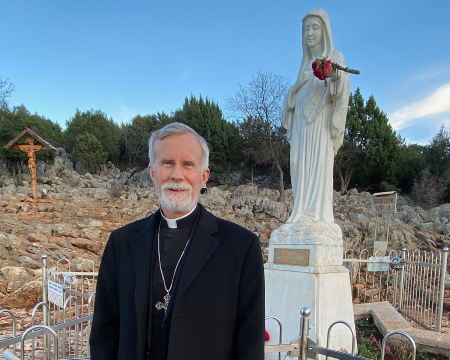We ask you, humbly: don't scroll away.
Hi readers, it seems you use Catholic Online a lot; that's great! It's a little awkward to ask, but we need your help. If you have already donated, we sincerely thank you. We're not salespeople, but we depend on donations averaging $14.76 and fewer than 1% of readers give. If you donate just $5.00, the price of your coffee, Catholic Online School could keep thriving. Thank you.Help Now >
Abbey of Waldsassen
FREE Catholic Classes
("Settlement in the woods").
Located on the River Wondreb, Upper Palatinate, near the border of Bohemia, in the Diocese of Ratisbon. This celebrated Cistercian monastery was founded by Gerwich von Wolmundstein, a Benedictine monk of the Abbey of Sigeberg, with the permission of his former Abbot Kuno, then Bishop of Ratisbon. Gerwich built the monastery (1128-32). The original community was sent to Waldsassen from Volkenrod, in Thuringia, of the line of the Abbey of Morimond. The first abbot was elected in 1133. Soon the monastery became one of the most renowned and powerful of the times. As the number of monks increased, several important foundations were made: Sedlitz and Ossegg in Bohemia ; Walderbach, near Ratisbon ; etc. Several of its thirty-seven abbots up to the Reformation were illustrious for sanctity and learning; of them Herman the seventh, and John the seventeenth, as well as Gerwich, its founder, and Wigand, the first prior, are commemorated in the menology.
From the middle of the fourteenth century Waldsassen alternated with periods of prosperity and decadence; wars, famines, excessive taxation, and persecution from the Hussites made it suffer much. During the Bavarian War (1504) the monastery, church, and farm- buildings were burned, but immediately afterwards rebuilt, and the new church consecrated in 1517. A few years later part of the buildings were again destroyed during war, and beautifully restored by George III (1531-37), who was the last of the first series of abbots. From 1537 to 1560 administrators were appointed by civil authorities. Frederick III, Elector Palatine, named his brother Richard, for this office. The monks were then forced to apostatize or flee, or were put to death. For about a hundred years it remained in this condition, during which time it was almost totally burned in the Swedish war. After the Peace of Westphalia the Catholic religion was restored in Bavaria. In 1669 Waldsassen was restored to the Cistercians, and in 1690 Albrecht, first of the second series of abbots (six in number), was elected. The buildings were sumptuously rebuilt, and the number of religious again became considerable. It became especially renowned for its hospitality, particularly during the famines of 1702-03 and 1772- 73, and during the French Revolution. Under Abbot Athanasius (1793-1803) science and learning were highly cultivated. When the monastery fell under the laws of suppression in 1803 it numbered over eighty members, who were dispersed after having been granted a pension by the Crown, which confiscated all their possessions. In 1863 the remnants of the old abbey were bought by the Cistercian Nuns of Seligenthal; the following year they took possession, established monastic enclosure, and opened an institute for the education of girls. Finally it was erected into a regular monastery, with novitiate, to which many candidates have been admitted; today the monastery numbers over a hundred nuns.
We ask you, humbly: don't scroll away.
Hi readers, it seems you use Catholic Online a lot; that's great! It's a little awkward to ask, but we need your help. If you have already donated, we sincerely thank you. We're not salespeople, but we depend on donations averaging $14.76 and fewer than 1% of readers give. If you donate just $5.00, the price of your coffee, Catholic Online School could keep thriving. Thank you.Help Now >








 Daily Readings for Saturday, April 20, 2024
Daily Readings for Saturday, April 20, 2024 St. Marian: Saint of the Day for Saturday, April 20, 2024
St. Marian: Saint of the Day for Saturday, April 20, 2024 Children's Prayer For Parents: Prayer of the Day for Saturday, April 20, 2024
Children's Prayer For Parents: Prayer of the Day for Saturday, April 20, 2024

